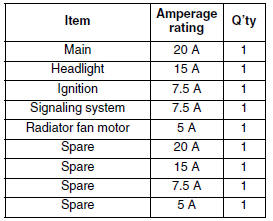Yamaha YZF-R125 Service Manual: Checking the fuses
The following procedure applies to all of the fuses.
| CAUTION: To avoid a short circuit, always turn the main switch to "OFF" when checking or replacing a fuse. |
1. Remove:
- Rider seat Refer to "GENERAL CHASSIS" on page 4-1.
2. Check:
- Fuse
a. Connect the pocket tester to the fuse and check the continuity.
Set the pocket tester selector to "
 × 1".
× 1".
b. If the pocket tester indicates " ", replace the fuse.
3. Replace:
- Blown fuse
a. Set the main switch to "OFF".
b. Install a new fuse of the correct amperage rating.
c. Set on the switches to verify if the electrical circuit is operational.
d. If the fuse immediately blows again, check
the electrical circuit
| WARNING Never use a fuse with an amperage rating other than that specified. Improvising or using a fuse with the wrong amperage rating may cause extensive damage to the electrical system, cause the lighting and ignition systems to malfunction and could possibly cause a fire. |
4. Install:
- Rider seat Refer to "GENERAL CHASSIS" on page 4-1.
 Checking the condition of the bulb sockets
Checking the condition of the bulb sockets
The following procedure applies to all of the bulb
sockets.
1. Check:
Bulb socket (for continuity)
(with the pocket tester)
No continuity Replace.
NOTE:
Check each bulb socket for continui ...
 Checking and charging the battery
Checking and charging the battery
WARNINGBatteries generate explosive hydrogen gas
and contain electrolyte which is made of poisonous
and highly caustic sulfuric acid.
Therefore, always follow these preventive
mea ...
Other materials:
Adjusting the exhaust gas volume
NOTE:
Be sure to set the CO density level to standard,
and then adjust the exhaust gas volume.
1. Remove:
Rider seat
Refer to "GENERAL CHASSIS" on page 4-1.
2. Set the main switch to "OFF".
3. Disconnect:
Self-diagnosis signal connector "1"
4. Connect:
FI diagnostic tool "2 ...
Checking the brake fluid level
1. Stand the vehicle on a level surface.
NOTE:
Place the vehicle on a suitable stand.
Make sure the vehicle is upright.
2. Check:
Brake fluid level
Below the minimum level mark "a" → Add the
recommended brake fluid to the proper level.
A. Front brake
B. Rear brake
WA ...
Removing the cylinder head
1. Align:
"I" mark "a" on the generator rotor
(with the stationary pointer "b" on the generator
cover)
a. Turn the crankshaft counterclockwise.
b. When the piston is at TDC on the compression
stroke, align the "I" mark "c" on the camshaft
sprocket with the mark "d" on the
cylinder h ...
